Disk Drive
-
- Del Norte Introduces Model 2006 GPS Receiver Maritime Reporter, May 1992 #19
Del Norte Technology Inc., Euless, Texas, has introduced the Model 2006 GPS system, one of the latest additions to its GPS product line.
The 2006 is a 6-channel LI C/A code GPS receiver which comes with a built-in PC and rugged splashproof case. The system allows for flexible data logging and processing capabilities for almost any application.
The system was designed primarily as a differential GPS mobile station.
Included with the system is a built-in LCD display, support for external monitors, six userconfigurable RS 232 serial ports for flexible communications, internal logging memory and a 3.5-inch floppy disk drive.
Also included is a software package for navigation and guidance, helmsman graphics, and user-selectable interfaces for a wide range of depth sounders.
Del Norte has been in business for over 23 years and its products are marketed worldwide through 12 service centers.
For more information detailing the Model 2006 GPS system, Circle 63 on Reader Service Card
-
- HydroComp Offers New Ship Propulsion Design Software Maritime Reporter, Oct 1989 #6
menu system and data entry screens. NavCad 2.0 requires an IBM PC or compatible computer operating MS-DOS 3.0 or greater, with 640K RAM, and a hard disk drive. A numeric coprocessor, and EGA or VGA video are recommended. NavCad supports 5-1/4- and 3-1/2-inch formats. For free literature detailing Nav- Cad
-
- New Briefcase Computer For Marine Industry From NAV-COM Maritime Reporter, Dec 1985 #12
can communicate with a wide assortment of personal computers and mainframes. It can be configured for up to 512K RAM and 512K ROM, and a 10 MB hard disk drive is available as an option. A built-in rechargeable battery pack permits the computer to be used without external power. An optional 1,200- bps
-
- Texas Instruments Offers New GPS Software Maritime Reporter, Feb 1986 #43
Corn- puter with 256K bytes RAM, a multifunction board with an additional 256K RAM, a single floppy diskette drive, a 10-megabyte Winchester hard disk drive, an 8087 coprocessor, three-plane graphics board, a built-in high-resolution 9-inch color monitor, two Memtec cassette readers, two RS-232 cables
-
- Furuno Introduces N e w Products Maritime Reporter, Dec 1987 #6
of the clearest, sharpest, most comprehensive plot pictures in the industry, with more than 5,000 pixels per square inch. A built-in 3.5-inch floppy disk drive has the capacity to store up to seventy 2,000-point digitized charts, and the system provides free selection of seven plotting colors and full remote
-
- NAVIGATION & COMMUNICATIONS EQUIPMENT Maritime Reporter, Dec 1986 #54
Computer with 256K bytes RAM, a multifunction board with an additional 256K RAM, a single floppy diskette drive, a 10-megabyte Winchester hard disk drive, an 8087 coprocessor, three-plane graphics board, a built-in high-resolution 9-inch color monitor, two Memtec cassette readers, two RS-232 cables
-
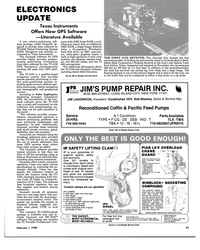 )
February 1986 - Maritime Reporter and Engineering News page: 41
)
February 1986 - Maritime Reporter and Engineering News page: 41puter with 256K bytes RAM, a mul- tifunction board with an additional 256K RAM, a single floppy diskette drive, a 10-megabyte Winchester hard disk drive, an 8087 coproces- sor, three-plane graphics board, a built-in high-resolution 9-inch color monitor, two Memtec cassette read- ers, two RS-232
-
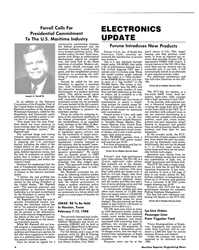 )
December 1987 - Maritime Reporter and Engineering News page: 4
)
December 1987 - Maritime Reporter and Engineering News page: 4the clearest, sharpest, most comprehensive plot pictures in the industry, with more than 5,000 pixels per square inch. A built-in 3.5-inch floppy disk drive has the capacity to store up to sev- enty 2,000-point digitized charts, and the system provides free selec- tion of seven plotting colors and
-
 )
May 1992 - Maritime Reporter and Engineering News page: 19
)
May 1992 - Maritime Reporter and Engineering News page: 19for external monitors, six user- configurable RS 232 serial ports for flexible communications, internal logging memory and a 3.5-inch floppy disk drive. Also included is a software pack- age for navigation and guidance, helmsman graphics, and user-select- able interfaces for a wide range of
-
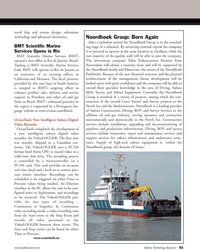 )
June 2011 - Marine Technology Reporter page: 55
)
June 2011 - Marine Technology Reporter page: 55. The first unit was recently shipped to a Canadian cus- tomer. The VideoLOGGER uses a PC104 format Intel Atom CPU to record video to a solid-state disk drive. The recording process is controlled by a microcontroller on a PC104 card. This card provides an accurate real time clock and a built-in or remote
-
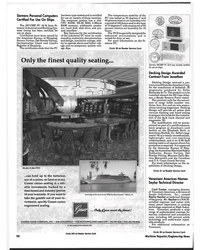 )
March 1993 - Maritime Reporter and Engineering News page: 56
)
March 1993 - Maritime Reporter and Engineering News page: 56use on vessels of these societies. The computer system has a slot- CPU 80386, SX-20 MHz 8-Mbyte RAM memory, arithmetic proces- sor, hard disk, disk drive and pro- cess interface. Key features for the certification of the industrial PC were its work- manship, materials, documentation and design
-
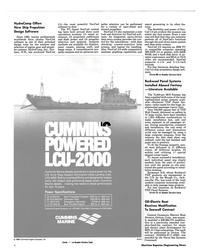 )
October 1989 - Maritime Reporter and Engineering News page: 4
)
October 1989 - Maritime Reporter and Engineering News page: 4system and data entry screens. NavCad 2.0 requires an IBM PC or compatible computer operating MS-DOS 3.0 or greater, with 640K RAM, and a hard disk drive. A nu- meric coprocessor, and EGA or VGA video are recommended. NavCad supports 5-1/4- and 3-1/2-inch formats. For free literature detailing
-
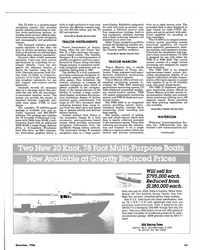 )
December 1986 - Maritime Reporter and Engineering News page: 59
)
December 1986 - Maritime Reporter and Engineering News page: 59with 256K bytes RAM, a mul- tifunction board with an additional 256K RAM, a single floppy diskette drive, a 10-megabyte Winchester hard disk drive, an 8087 coproces- sor, three-plane graphics board, a built-in high-resolution 9-inch color monitor, two Memtec cassette read- ers, two RS-232
-
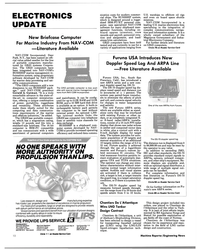 )
December 1985 - Maritime Reporter and Engineering News page: 10
)
December 1985 - Maritime Reporter and Engineering News page: 10marine management soft- ware from NAV-COM Incorporated. and mainframes. It can be config- ured for up to 512K RAM and 512K ROM, and a 10 MB hard disk drive is available as an option. A built-in rechargeable battery pack permits the computer to be used without external power. An optional 1,200- bps
